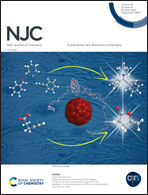Molecularly imprinted QCM sensor based on delaminated MXene for chlorpyrifos detection and QCM sensor validation
Abstract
Chlorpyrifos (CHL) is one of the most frequently used broad-spectrum organophosphate insecticides. Especially, its incorrect and uncontrolled usage cause public concern about food and environment safety. In this report, a new molecularly imprinted quartz crystal microbalance (QCM) sensor on delaminated sulfur-doped MXene (d-S-Ti3C2TX MXene) was prepared for CHL. The structures of the bare MAX phase (Ti3AlC2), sulfur-doped MAX phase (S-Ti3AlC2), wrinkled sulfur-doped MXene (S-Ti3C2TX MXene) and d-S-Ti3C2SX MXene were highlighted by scanning electron microscopy (SEM), transmission electron microscopy (TEM), atomic force microscopy (AFM), X-ray photoelectron spectroscopy (XPS), Fourier transform infrared spectroscopy (FTIR), electrochemical impedance spectroscopy (EIS), cyclic voltammetry (CV) and X-ray diffraction (XRD). The CHL imprinted QCM sensor was prepared in the presence of MAGA and CHL in 2 : 1 molar ratio. From the analytical results 1.0 × 10−12–1.0 × 10−10 M and 3.0 × 10−13 M were found to be the linearity range and detection limit (LOD), respectively. Furthermore, the CHL imprinted QCM sensor was examined in terms of stability, repeatability, reproducibility and reusability. Finally, the imprinted sensor was applied to orange juice samples, and a high recovery was obtained.



 Please wait while we load your content...
Please wait while we load your content...